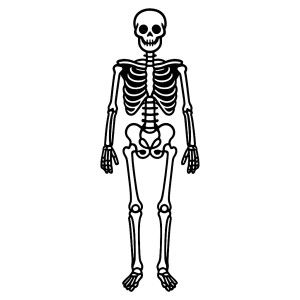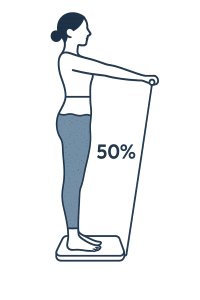-
 The 'five' key body pod metrics;
The 'five' key body pod metrics;💪 Muscle Mass
🦴 Bone Mass
⚖️ Body Fat Mass
💧 Body Water Percentage
📆 Metabolic Age
- - - - - - - - - - - - - - - - - - - - - - - - - - - - - - - - - - - - - - - - - - - - - - - - - - - - - - - - - -
1. Muscle Mass
Why it matters:
Muscle tissue is highly metabolically active—it burns significantly more calories at rest than fat does. Higher muscle mass boosts basal metabolic rate (BMR) and supports strength, mobility, and overall functional fitness. A loss in muscle (sarcopenia) can impair mobility and increase injury risk.
In the context of body composition & fitness:
Tracking muscle mass helps ensure gains are lean tissue—not just weight. This is crucial for progressive training and helps individuals avoid losing muscle during weight loss. I strongly support and recommend some form of resistance exercise or movement to ensure continued muscle health.
🎯 Although relative, global data indicate that having 50%+ of total weight as muscle mass is excellent.
- - - - - - - - - - - - - - - - - - - - - - - - - - - - - - - - - - - - - - - - - - - - - - - - - - - - - - - - - -
2. Bone Mass

Why it matters:
Bone mass is integral to structural strength, mobility, and long-term skeletal health. Suboptimal bone density heightens the risk of osteoporosis and fractures—especially relevant in older or sedentary populations.
In the context of wellness:
Monitoring bone mass allows early identification of decline and supports timely interventions—like resistance training, calcium/vitamin D intake, and lifestyle modifications—tailored for bone health. I take particular interest in the bone mass of females aged 45plus. Again, resistance activity appears to show the best skeletal results.
🎯 Although relative, global data indicate that having 13%+ of total weight as bone mass is excellent.
- - - - - - - - - - - - - - - - - - - - - - - - - - - - - - - - - - - - - - - - - - - - - - - - - - - - - - - - - -
3. Body Fat Mass
Why it matters:
Beyond total weight, knowing how much comes from fat—especially visceral fat—is vital. Excess body fat is linked to metabolic diseases like diabetes, hypertension, and cardiovascular disorders.
In the context of health tracking:
Body fat percentage reveals true changes—e.g., someone could maintain the same weight but lose fat and gain muscle (a net positive). This nuance is far more insightful than traditional metrics like BMI. A fitting nutritional plan, typically low in sugar, refined oils and industrialised salt, appears to be the best approach.
🎯 Although 'relative', global data indicate that having <20% (M) & <27% (F) of subcutaneous fat mass is healthy.
- - - - - - - - - - - - - - - - - - - - - - - - - - - - - - - - - - - - - - - - - - - - - - - - - - - - - - - - - -
4. Body Water Percentage

Why it matters:
Water constitutes a major part of lean mass and directly influences hydration status. Hydration profoundly affects performance, recovery, thermoregulation, metabolism, and measurement accuracy for other BI-based metrics.
In the context of monitoring:
Tracking water ensures fluctuations aren’t misinterpreted—e.g., weight changes could be hydration-related. It also supports optimal training and wellness. Regular water throughout the day with the inclusion of vital minerals appears to offer the best hydration status.
🎯 Although relative, global data indicate that having 50+ of body water percentage is excellent.
- - - - - - - - - - - - - - - - - - - - - - - - - - - - - - - - - - - - - - - - - - - - - - - - - - - - - - - - - -
5. Metabolic Age
Why it matters:
Metabolic age estimates how efficiently your metabolism runs compared to population averages of your chronological age. It’s calculated by comparing BMR with typical values for your age bracket.
👍 If your metabolic age is lower, your metabolism is comparatively efficient.
👎 If higher, it may suggest slower metabolic function—often linked to higher fat mass, lower muscle, or less active habits.
In the context of behaviour change:
Though not diagnostic, metabolic age can be motivating. It personalises data, turning abstract metabolic health into actionable insight—encouraging targeted diet, exercise, and lifestyle shifts.
- - - - - - - - - - - - - - - - - - - - - - - - - - - - - - - - - - - - - - - - - - - - - - - - - - - - - - - - - -
Why These Five Are Especially Relevant — and Not Misleading
✅ Holistic view: They cover the major body composition compartments—lean tissue (muscle & bone), fat, water, plus functional insight via metabolism.
✅ Actionable: Each metric informs a different area: strength training (muscle), skeletal health (bone), fat reduction (body fat), hydration strategies, and metabolic conditioning.
✅ Segmental accuracy: Devices like the Hume Body Pod use multi-frequency BIA and multiple electrode points to deliver refined, segmental data—not just global averages—enhancing accuracy and mapping imbalances across limbs and trunk.
✅ Motivational and educational: Users gain clarity on how lifestyle choices impact their numbers, which is more empowering than relative global percentile comparisons.
Metric
Importance
Muscle Mass
Enhances metabolic rate, strength, mobility
Bone Mass
Reflects skeletal health and future fracture risk
Body Fat Mass
Key indicator for metabolic and disease risk
Body Water %
Critical for hydration, athletic performance, and accuracy
Metabolic Age
Reflects metabolic efficiency; motivates healthy behaviours
Practical Takeaways for your Wellness
💪 Use muscle mass tracking to tailor resistance training programs and ensure lean gains—not just scale weight loss.
🦴 Track bone mass, especially across age-diverse groups, to guide nutrition and activity interventions that support skeletal health.
⚖️ Monitor fat mass to assess true improvements in body composition and identify areas for targeted fat reduction.
💧 Watch body water fluctuations to prevent misinterpretation of fat/muscle changes and to guide hydration strategies in wellness programming.
📆 Leverage metabolic age as an engaging, understandable metric that reflects metabolic improvements and can inspire individuals to stick with healthier habits.
Final Thoughts
Together, these five metrics offer a nuanced and robust framework that aligns perfectly with evidence-based fitness, metabolic health, and long-term wellness strategies. Paired with a precise tool like the Hume Body Pod, they empower you to deliver personalised, informed, and motivational insights—not just numbers on a scale. Please feel comfortable approaching Brad Pamp for your personalised plan.
